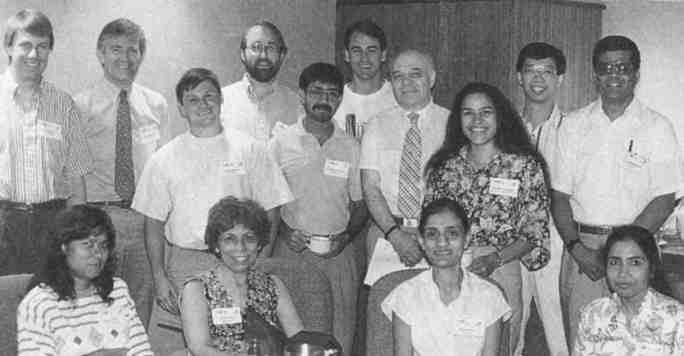


Meeting report
Fiber Diffraction from Biological Macromolecules
 Jerry Karle and the Fiber people: (seated left to right) R. Ghosh, Y. Mascarenhas, A. Radha, R. Pattanayek, (standing left to right) R. Millane, J. Blackwell, W. Stroud, T. Hendrixson, D. Chattopadhyay, T. Planchart, J. Karle, M. Venugopal, unidentified, and R. Chandrasekaran at the ACA/Pittsburgh Diffraction Meeting, August 1992. (Photo WLD)
Jerry Karle and the Fiber people: (seated left to right) R. Ghosh, Y. Mascarenhas, A. Radha, R. Pattanayek, (standing left to right) R. Millane, J. Blackwell, W. Stroud, T. Hendrixson, D. Chattopadhyay, T. Planchart, J. Karle, M. Venugopal, unidentified, and R. Chandrasekaran at the ACA/Pittsburgh Diffraction Meeting, August 1992. (Photo WLD)
Fiber Diffractionists gathered at McCormick's Creek State Park, Indiana, USA in June 1993, for the "Second Workshop on Fiber Diffraction from Biological Macromolecules." In the year marking the 40th anniversary of the discovery of the double-helix structure of DNA, in which fiber diffraction played a crucial role, presentations by W. Fuller and R. Chandrasekaran reminded us that fiber diffraction is still providing detailed information on the structures of polymeric nucleic acids. The workshop was sponsored by the Whistler Center for Carbohydrate Research at Purdue University, and E. I. du Pont de Nemours and Co.
The emphasis of the workshop was on methodology. R. Denny and T. Hendrixson described computational techniques for quantitating background and diffuse diffraction in fiber diffraction patterns. A general formalism for calculating diffraction patterns from disordered polycrystalline fiber specimens, a necessary prelude to use of such data in structure determination, was described by W. Stroud. The application of molecular dynamics to the refinement of structures with fiber diffraction data, a method for escaping from local minima, was discussed by H. Wang. Structural studies on a variety of polysaccharides, including welan, a debranched arabanan, mannan, and konjac mannan (A. Radha, M. Zhang, R. Millane) were described, as well as detailed structures of nucleic acids (W. Fuller, R. Chandrasekaran), including the location of cations and water molecules. Both low resolution and highly refined structures of larger biological assemblies including the bacteriophage M13 (G. Kishchenko), several members of the tobacco mosaic virus group (G. Stubbs), and Alzheimer beta-amyloid protein analogs (D. Kirschner), were also presented.
W. Fuller, Keele U., UK, described applications of X-ray synchrotron and neutron radiation to the determination of high resolution nucleic acid structures, as well as characterization of stereochemical pathways during nucleic acid structural transitions and during drawing and annealing of synthetic polymers. J. Squire (Imperial College, UK) described an ambitious proposal, and preliminary results, for a dynamic study of muscle contraction using low angle, time-resolved synchrotron X-ray diffraction from electrically triggered muscle on the ms time scale, and synthesizing this data with other independent structural data, to obtain information on the molecular events involved.
Round-table discussions on specimen preparation, data collection, and phasing and refinement, proved particularly valuable in alerting us to techniques and protocols used in different laboratories. The third workshop is planned for 1996 in Florida.
Rick Millane, Chairman


